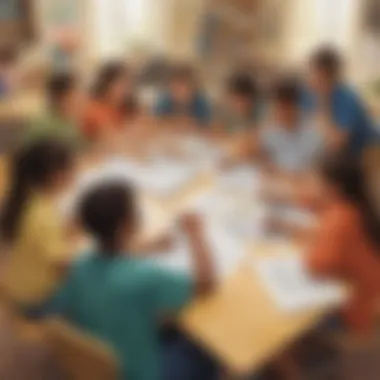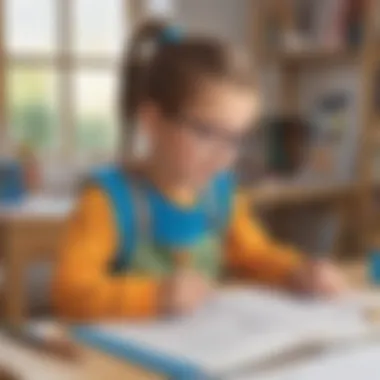Unlocking the Secrets of Effective Learning for Elementary Students


Creative Activities
Curating activities that nurture a child's creativity is crucial in developing their cognitive abilities. By engaging in hands-on craft ideas, children can enhance their motor skills and unleash their imagination. Sharing easily replicable craft ideas allows young learners to explore their artistic side with step-by-step guides provided for each activity. Furthermore, discussing the educational value of these activities sheds light on how they not only entertain but also educate, fostering a holistic learning environment for elementary school children.
Fun Quizzes
Incorporating fun quizzes into the learning process adds an interactive dimension that captivates young minds. Various quiz topics covering a wide array of subjects are available on ElemFun, ensuring children have access to diverse learning experiences. With explanations on different question types used in these quizzes, children can engage with the content effectively. The quizzes serve as a tool for knowledge reinforcement, aiding in the retention and application of information learned, thus solidifying the learning process.
Fact-Based Articles
Exploring fact-based articles introduces children to a wealth of knowledge across different topics. These articles are crafted to present complex information in an engaging and easy-to-understand manner, making learning enjoyable for young readers. Touching upon a myriad of topics, from science to literature, these articles offer insights that spark curiosity and encourage further exploration. Providing additional resources in the form of links to related articles or external sources expands the learning horizon, nurturing a habit of seeking knowledge beyond the conventional classroom setting.
Introduction
Understanding the Importance of Learning
Benefits of Lifelong Learning
Embarking on the exploration of the "Benefits of Lifelong Learning" unveils a treasure trove of advantages waiting to be harnessed by eager young minds. Lifelong learning, with its emphasis on continuous growth and development, offers a transformative avenue for students to expand their knowledge horizons beyond conventional academic boundaries. By instilling a thirst for ongoing learning, children can cultivate resilience, adaptability, and a relentless pursuit of excellence. The unique allure of lifelong learning lies in its ability to foster a growth mindset that transcends age or confines, paving the way for a future generation that embraces challenges with unwavering determination and intellectual prowess.
Impact of Education on Future Opportunities
Delving into the profound realm of the "Impact of Education on Future Opportunities," we uncover the pivotal role that education plays in shaping the trajectory of young lives. Education forms the bedrock upon which aspirations are built, opening doors to a myriad of possibilities and pathways towards success. By investing in a quality education, children can equip themselves with the necessary skills, knowledge, and competencies to carve out a promising future filled with enriching opportunities. The transformative power of education not only empowers students to achieve their dreams but also instills in them a sense of purpose, curiosity, and lifelong learning that transcends the confines of traditional schooling.
Overview of the Learning Process
Engagement in Active Learning
At the core of effective learning lies the fundamental tenet of "Engagement in Active Learning." This dynamic approach to acquiring knowledge places students at the center of their educational journey, fostering deep understanding, critical thinking, and practical application of concepts. By immersing young learners in hands-on experiences, interactive discussions, and real-world projects, active learning cultivates a holistic learning experience that goes beyond rote memorization. The intrinsic value of engagement in active learning lies in its capacity to ignite a passion for discovery, experimentation, and collaborative problem-solving among students, laying the groundwork for a lifelong love affair with learning.
Role of Curiosity in Knowledge Acquisition
Unveiling the enigmatic realm of the "Role of Curiosity in Knowledge Acquisition," we unravel the profound influence that a curious mindset exerts on the learning process. Curiosity serves as the spark that ignites intellectual inquiry, drives exploration, and fuels a relentless quest for understanding. By nurturing and encouraging curiosity in young learners, educators can stimulate a sense of wonder, creativity, and innovation that paves the way for breakthrough discoveries and novel insights. The innate allure of curiosity lies in its transformative potential to transform passive learners into avid seekers of knowledge, instilling in them a thirst for discovery that transcends the boundaries of traditional educational paradigms.
Developing a Growth Mindset
Developing a Growth Mindset is a critical aspect of the educational journey detailed in this article. It plays an essential role in shaping students' perspectives towards learning, highlighting the significance of effort and perseverance. By instilling a Growth Mindset, children can embrace challenges with a positive attitude, viewing mistakes as opportunities for growth. This section emphasizes the importance of resilience and persistence in overcoming obstacles, laying the foundation for academic success and personal development.
Embracing Challenges and Mi'stakes


Importance of Persistence
Persisten5ce is a vital attribute that fuels continuous learning and progress within the educational context. By demonstrating perseverance and determination, students can navigate through difficulties and setbacks, ultimately achieving their academic goals. Persistence encourages individuals to stay focused on their objectives, fostering a sense of accomplishment and self-efficacy. In this article, the Importance of Persistence is portrayed as a key driver of success, empowering young learners to confront obstacles with grit and resilience.
Cultivating Resilience in Learning
Cultiv5ating Resilience in Learning is essential for students to adapt to new challenges and uncertainties. Resilience enables individuals to bounce back from failures, setbacks, and disappointments, fostering emotional strength and adaptability. By nurturing resilience, students develop the capacity to cope with academic pressures and setbacks constructively. This section highlights the significance of resilience in building a Growth Mindset, emphasizing its role in shaping students' attitudes towards learning.
Fostering a Positive Attitude Towards Learning
Fostering a Positive Attitude Towards Learning is a cornerstone of educational success for elementary school children. By embracing feedback con'structively, students can leverage criticism as a tool for improvement and growth. Constructive feedback provides valuable insights and opportunities for self-reflection, enabling students to refine their skills and strategies. This article underscores the importance of feedback in nurturing a positive learning environment, encouraging students to embrace challenges with enthusiasm and openness.
Growth Mindset vs. Fixed Mindset
The comparison between a Growth Mindset and a Fixed Min'set sheds light on two distinct outlooks towards learning and development. A Growth Mindset fosters a belief in one's ability to learn and improve through effort, while a Fixed Mindset limits growth by embracing inherent limitations. By showcasing the advantages of a Growth Mindset over a Fixed Mindset, this article underscores the importance of adaptive and resilient thinking in educational pursuits. Encouraging students to cultivate a Growth Mindset sets the stage for continuous learning and achievement, promoting a proactive approach to academic challenges and opportunities.
Utilizing Technology for Learning
Utilizing technology for learning in the context of this article plays a pivotal role in enhancing educational experiences for elementary school children. Technology serves as a catalyst for engagement and interactive learning, fostering a dynamic approach to knowledge acquisition. By incorporating technological tools, students can explore a wealth of resources and engage with content in innovative ways, catering to diverse learning styles and preferences. The seamless integration of technology into learning processes not only amplifies educational outcomes but also cultivates invaluable digital literacy skills essential for the future.
Interactive Educational Resources
E-Learning Platforms
E-Learning platforms constitute a fundamental component of the digital education landscape, providing students with access to a vast array of online courses, interactive modules, and virtual classrooms. The flexibility and convenience offered by E-Learning platforms enable learners to personalize their learning journeys according to their pace and preferences. One of the key characteristics of E-Learning platforms is their ability to cater to individual learning needs, offering adaptive learning experiences tailored to each student's strengths and areas for improvement. This adaptability enhances the efficacy of learning interventions and optimizes knowledge retention and application. With interactive features such as quizzes, simulations, and multimedia content, E-Learning platforms create an immersive learning environment that fosters active engagement and knowledge assimilation.
Benefits of Educational Apps
Educational apps have revolutionized the educational landscape by providing interactive and engaging tools that supplement traditional learning approaches. The key characteristic of educational apps lies in their ability to transform abstract concepts into tangible, interactive experiences that resonate with young learners. These apps offer a dynamic and personalized learning experience, catering to diverse learning styles and preferences. By incorporating gamified elements, real-time feedback, and adaptive difficulty levels, educational apps enhance learner motivation and retention. The unique feature of educational apps is their versatility, spanning a wide range of subjects and skills, from language arts to STEM disciplines. While educational apps offer unparalleled accessibility and convenience, it is essential to consider factors such as app credibility, age-appropriate content, and parental guidance to ensure a safe and empowering learning experience for children.
Digital Tools for Effective Studying
Note-Taking Apps
Note-taking apps streamline the process of capturing and organizing information, facilitating effective study practices and knowledge retention. The key characteristic of note-taking apps is their user-friendly interface and intuitive features, allowing students to create, edit, and categorize notes seamlessly. These apps enable students to consolidate information from various sources, annotate key points, and create personalized study aids. The unique feature of note-taking apps lies in their synchronization capabilities across devices, ensuring seamless access to study materials anytime, anywhere. While note-taking apps enhance study efficiency and organization, users must exercise critical judgment in discerning relevant information and maintaining succinct notes to optimize learning outcomes.
Online Research Techniques
Online research techniques empower students to access a wealth of information and resources to deepen their understanding of various topics and subjects. The key characteristic of online research techniques is their ability to provide a diverse range of sources, including academic journals, educational websites, and multimedia content. By honing skills in keyword searches, source evaluation, and information synthesis, students can refine their research abilities and navigate digital platforms effectively. The unique feature of online research techniques is their capacity to promote critical thinking, information literacy, and academic integrity among young learners. While online research offers a vast repository of knowledge, students must exercise caution in verifying sources, discerning credible information, and avoiding plagiarism to uphold academic rigor and intellectual honesty.


Creating a Personalized Learning Environment
In the realm of educational advancement for elementary school children, the significance of creating a personalized learning environment cannot be overstated. Tailoring the learning space to cater to the specific needs and preferences of each child enhances their overall learning experience. By customizing the environment, children are more likely to be engaged and motivated, leading to improved academic performance. Moreover, a personalized learning environment fosters a sense of ownership and responsibility in students, instilling a proactive attitude towards their education.
Setting learning goals is a pivotal aspect of a child's educational journey, playing a crucial role in guiding their academic progress. SMART goal setting, a method that emphasizes Specific, Measurable, Achievable, Relevant, and Time-bound objectives, is instrumental in this process. This approach ensures that goals are well-defined, trackable, and realistic, aligning with a child's capabilities and aspirations. SMART goal setting not only promotes focused learning but also instills a sense of accomplishment as students reach and surpass their set objectives.
Tracking progress and achievements serves as a vital component in the learning process, providing students with valuable feedback on their performance. By monitoring their progress, children can identify areas of strength and weakness, enabling them to make informed adjustments to their study routine. Celebrating achievements, no matter how small, motivates students to persevere and strive for continuous improvement. Additionally, tracking progress offers a sense of accountability, encouraging students to stay committed to their academic goals.
Establishing a consistent study routine is key to maintaining academic discipline and maximizing learning effectiveness. Time management strategies help children allocate their time efficiently, ensuring a balanced approach to studying and recreational activities. By prioritizing tasks and creating a structured schedule, students develop essential organizational skills that benefit them beyond the academic realm. Moreover, effective time management cultivates a sense of time awareness and punctuality, laying a strong foundation for future endeavors.
Creating a distraction-free workspace is essential in optimizing a child's study environment. A workspace devoid of distractions promotes concentration and minimizes interruptions, enabling students to focus their full attention on learning tasks. Designating a specific area for study that is free from noise, clutter, and electronic distractions enhances cognitive function and boosts productivity. By customizing their workspace to suit their studying needs, children can foster a conducive learning atmosphere that facilitates mental acuity and knowledge retention.
Enhancing Study Techniques
In the realm of academic excellence, the significance of honing study techniques transcends mere comprehension; it is an art that aids in truly mastering the learning process. By excavating deep into the essence of enhancing study techniques, elementary school children can unearth the treasure trove of methods that elevate their scholastic journey. Understanding the pivotal role played by study techniques is akin to unraveling the secrets to efficient knowledge absorption. Students are encouraged to embark on a voyage of self-discovery, exploring a myriad of approaches that align with their unique learning styles and preferences. The benefits are manifold, ranging from improved retention of information to heightened analytical skills. Children are beckoned to navigate through the intricate web of study techniques, each strand intricately woven to enhance their intellectual prowess and academic acumen.
Effective Note-Taking Methods
Cornell Note-Taking System
Diving into the nuances of note-taking, the Cornell Note-Taking System emerges as a beacon of structured documentation. Its streamlined format encapsulates key concepts, enabling students to cultivate a systematic approach to information retention. The distinctive bifurcation of notes into cues, main points, and summaries fosters a comprehensive understanding of the subject matter. This meticulous organization aids in facilitating effective revision and reinforces the learning experience. The Cornell Note-Taking System acts as an indispensable ally in academic pursuits, equipping learners with a versatile tool for capturing knowledge effectively. Embracing this method empowers students to synthesize information cohesively, propelling them towards scholastic success.
Mind Mapping Techniques
Venturing into the realm of visual learning aids, Mind Mapping Techniques emerge as a dynamic tool for conceptual exploration. Their innate ability to transform complex ideas into digestible visual representations is a hallmark of their efficacy. By harnessing the power of associations and connections, students can unravel the intricate web of knowledge in a cohesive manner. Mind Mapping Techniques serve as a gateway to unlocking creativity and critical thinking, providing a canvas for ideas to flourish. The organic flow of information in a mind map stimulates holistic learning, activating both hemispheres of the brain. Integrating this approach not only enhances comprehension but also nurtures a deeper appreciation for the interconnectedness of various topics. Students are encouraged to embrace Mind Mapping Techniques as a catalyst for transformative learning experiences.
Active Reading Strategies
SQ3R Method
Embarking on the journey of active reading, the SQ3R Method emerges as a cornerstone of effective comprehension. Its systematic approach of Survey, Question, Read, Recite, and Review resonates with inquisitive young minds, fostering a proactive engagement with textual content. By navigating through the sequential stages of this method, students unlock a treasure trove of insights hidden within the pages of a text. The interactive nature of SQ3R cultivates a sense of ownership over the learning process, encouraging students to delve deep into the intricacies of a topic. This methodical approach not only enhances information retention but also sharpens critical thinking skills, laying a robust foundation for academic growth.
Annotating and Highlighting Texts
Venturing into the realm of textual analysis, the art of annotating and highlighting texts emerges as a gateway to insightful interpretation. The act of annotating encourages active engagement with the material, prompting students to internalize key concepts and ideas. By shining a light on pivotal points through highlighting, learners can navigate through the textual landscape with clarity and precision. The amalgamation of annotations and highlights serves as a roadmap for future reference, propelling students towards a deeper understanding of the subject matter. This dynamic duo of strategies not only aids in information retrieval but also fosters a sense of connection with the text, transforming reading into a transformative educational experience.
Exploring Diverse Learning Styles
Exploring Diverse Learning Styles holds significant importance in honing the learning journey for elementary school children. Understanding the various ways in which children comprehend and retain information is crucial for educators and parents alike. By delving into Visual, Auditory, and Kinesthetic learning styles, children can harness their strengths and adapt study techniques accordingly, fostering a more effective learning process. This section will explore the benefits, challenges, and considerations associated with catering to diverse learning styles in elementary education.


Visual, Auditory, and Kinesthetic Learning
Understanding Individual Learning Preferences
Exploring individual learning preferences is pivotal in tailoring educational approaches to meet the unique needs of each student. Visual learners thrive in environments where information is presented through images, graphs, and visual aids. Their ability to visualize concepts enhances comprehension and retention. On the other hand, auditory learners grasp information best through listening. Utilizing spoken explanations, recordings, and discussions caters to their learning style.
Understanding the distinct characteristics of individual learning preferences allows educators to create inclusive learning environments that accommodate a spectrum of needs effectively. Adapting teaching methods to cater to diverse preferences ensures that students engage more deeply with the material, leading to improved learning outcomes. Although challenges may arise in addressing various preferences simultaneously, the rewards of personalized education far outweigh the complexities.
Adapting Study Techniques Accordingly
Adapting study techniques according to individual learning preferences is a strategic approach to enhance academic performance. By customizing study methods to align with visual, auditory, or kinesthetic learning styles, students can optimize their learning potential. Visual learners may benefit from incorporating mind maps and color-coded notes, stimulating their visual memory. On the contrary, auditory learners can excel by utilizing mnemonic devices and participating in group discussions, reinforcing their understanding through verbal interaction. Kinesthetic learners, who learn best through hands-on activities, experience enhanced comprehension through experiments and practical applications, promoting active engagement and retention of information. Aligning study techniques with individual preferences fosters a supportive learning environment that empowers students to excel. Embracing the unique features of each learning style cultivates a holistic approach to education, catering to the diverse needs and strengths of young learners.
Incorporating Multisensory Learning Approaches
Hands-On Activities
Implementing hands-on activities in the educational framework enriches the learning experience and enhances knowledge retention. Hands-on activities engage students in practical experiences that stimulate their kinesthetic senses, promoting experiential, and interactive learning. From science experiments to art projects, these activities encourage creativity and critical thinking, fostering a deeper understanding of the curriculum. Moreover, hands-on activities provide a dynamic platform for students to apply theoretical knowledge in real-world scenarios. By actively participating in hands-on tasks, students internalize concepts more effectively, bridging the gap between theory and practice. While challenges such as resource availability and time constraints may arise, the benefits of hands-on activities in bolstering engagement and comprehension make them integral to a well-rounded educational experience.
Interactive Learning Games
Integrating interactive learning games into the learning environment offers a fun and captivating avenue for children to expand their knowledge and skills. Interactive games stimulate cognitive abilities, facilitating active learning pursuits and encouraging problem-solving skills. Through gamified learning, children can immerse themselves in educational content in a playful manner, enhancing their motivation and concentration. The instantaneous feedback and rewards within interactive games promote a sense of achievement and progress, motivating continuous engagement with the learning material. While considerations such as screen time and game selection need to be balanced appropriately, the interactive nature of these games fosters a dynamic learning environment that appeals to diverse learning preferences and enhances overall learning outcomes.
Embracing Continuous Learning
In the realm of educational excellence, discussing the significance of embracing continuous learning serves as a cornerstone for academic growth and personal development. Encouraging a mindset that values perpetual learning is vital for elementary school children to forge a path towards intellectual enrichment and success. Embracing continuous learning instills a sense of curiosity, resilience, and adaptability in young learners, nurturing their ability to navigate challenges and acquire new knowledge effectively. By fostering a culture of lifelong learning, students can proactively engage with a variety of resources and experiences, shaping them into versatile and well-rounded individuals poised for academic achievement and personal fulfillment.
Engaging in Lifelong Learning Opportunities
Enrolling in Extracurricular Activities
Enrolling in extracurricular activities presents a prime opportunity for young learners to expand their horizons beyond conventional academic pursuits. These activities, whether in sports, arts, or other disciplines, offer children a platform to cultivate essential life skills such as teamwork, leadership, and time management. Participating in extracurriculars not only enriches a child's social interactions but also enhances their overall cognitive abilities. The unique nature of extracurricular activities lies in their ability to provide hands-on learning experiences outside the traditional classroom setting, enabling students to discover and hone their talents and interests in a practical and engaging manner.
Exploring New Subjects and Hobbies
Delving into new subjects and hobbies acts as a gateway to limitless exploration and self-discovery for young minds eager to broaden their intellectual horizons. Exploring diverse subjects cultivates a sense of intellectual curiosity and allows students to uncover hidden passions and talents. By venturing into uncharted territories, children not only acquire new knowledge but also develop critical thinking skills and creativity. The process of exploring new subjects and hobbies empowers students to break free from limiting beliefs, fostering a growth mindset that thrives on novelty and innovation. While this exploration may pose challenges, the benefits of embracing new interests far outweigh any temporary setbacks, paving the way for holistic personal and academic development.
Seeking Mentorship and Guidance
Importance of Role Models in Learning
The influence of role models in shaping a child's educational journey cannot be understated. Role models serve as beacons of inspiration, providing young learners with tangible examples of success, perseverance, and integrity. By observing and emulating positive role models, children develop a strong sense of values and aspirations, guiding their academic and personal growth. Role models instill in students a belief in their own potential and a drive to overcome obstacles, fostering a resilient attitude towards challenges. The presence of role models in a child's life not only imparts valuable lessons but also instills a sense of purpose and direction in their pursuit of knowledge and self-improvement.
Learning from Experienced Individuals
Learning from experienced individuals offers a wealth of insights and wisdom that can profoundly impact a child's learning journey. By seeking guidance from mentors, elders, or experts in various fields, students gain access to a treasure trove of knowledge and guidance. Learning from experienced individuals allows children to benefit from the wisdom of those who have traversed similar paths before them, avoiding common pitfalls and maximizing learning outcomes. The mentorship of experienced individuals fosters a supportive learning environment where students feel motivated, encouraged, and empowered to reach their full potential. Drawing from the experiences of seasoned professionals not only accelerates a child's learning curve but also nurtures a sense of curiosity and determination essential for long-term success in academics and beyond.







